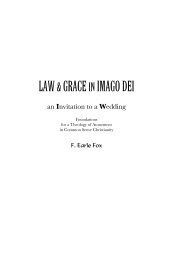Download entire 232-page book HERE (PDF ... - MassResistance
Download entire 232-page book HERE (PDF ... - MassResistance
Download entire 232-page book HERE (PDF ... - MassResistance
Create successful ePaper yourself
Turn your PDF publications into a flip-book with our unique Google optimized e-Paper software.
violence than heterosexuals (4,5,6,7). Statistics also show that children of violent relationships tend<br />
to repeat the violent behavior as adults (8).<br />
Selfishness is an integral element of non-committed relationships, and especially of homosexual<br />
relationships, which tend to be non-monogamous and also based on each partner’s need to exploit<br />
the other to “complete” his or her deficient gender identity: Dr. Joseph Nicolosi, a therapist for men<br />
seeking to escape homosexuality, describes this attempt at need-fulfillment: “Same-sex attractions<br />
will then substitute for the lost masculine within” (9). .<br />
As for the remaining character qualities, it is apparent that they are better modeled by two<br />
committed individuals of opposite genders, since this is the configuration that allows each partner to<br />
apply the greatest amount of effort and inner resources to cooperate with the other partner, whose<br />
different gender poses problems in understanding, sharing of perspective and coordinating of genderspecific<br />
roles and abilities. The commitment element is especially important here, since it allows all<br />
the family members to observe how problems and challenges are worked through, and adjustments<br />
fine-tuned, over a long period of time.<br />
1. More about unmarried different-sex couples, paragraph citing research from several sources on the Alternatives<br />
to Marriage website, http://www.unmarried.org/statistics.html.<br />
2. http://www.acpeds.org/?CONTEXT=art&cat=22&art=50.<br />
3. Roger Sider, M.D.,“Living Together Risky for Young Women and Children,” Grand Rapids Press January<br />
25, 1999, reproduced in the Divorce Statistics Collection of the website<br />
http://www.divorcereform.org/mel/adomesticviolence.html<br />
4. 2004 General Social Survey, Statistics Canada, Canada's National Statistical Agency, July 7, 2005.<br />
5. “A Descriptive Analysis of Same-Sex Relationship Violence for a Diverse Sample,” The Journal of Family<br />
Violence, Publisher Springer Netherlands, Volume 15, Number 3, September, 2000, Pages 281-293. ISSN<br />
0885-7482<br />
6. Greenwood, G., Relf, M., Huang, B., Pollack, L., Canchola, J., and Catania, J. (2002). “Battering victimization<br />
among a probability-based sample of men who have sex with men,” Amer. J. Pub. Health, 92: (12),<br />
1964-69.<br />
7. Tjaden, P., Thoennes, N., Allison, C. (1999). “Comparing violence over the life span in samples of<br />
same-sex and opposite-sex cohabitants,” Violence and Victims, 14(4): 413-425.<br />
8. Research on children who suffer family violence: from CAEPV, article summarizing recent research, on<br />
http://www.silentwitness.net/sub/latest_reserch.htm#children .<br />
9. Nicolosi, Joseph, Ph.D., “The Meaning of Same-Sex Attraction,” 2008, reproduced in the Documents<br />
section of the NARTH website, http.www.narth.com.<br />
Redeeming the Rainbow 83






